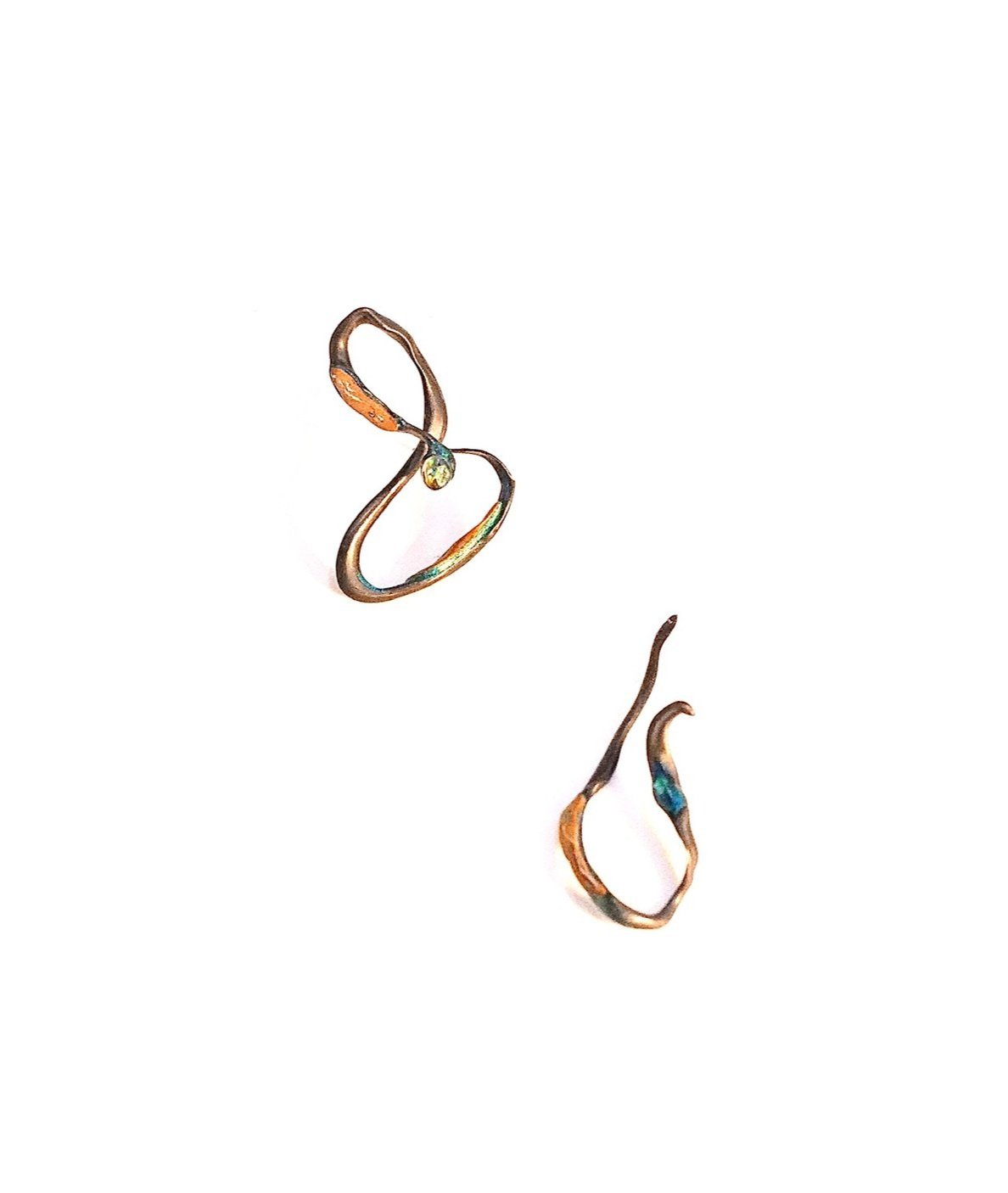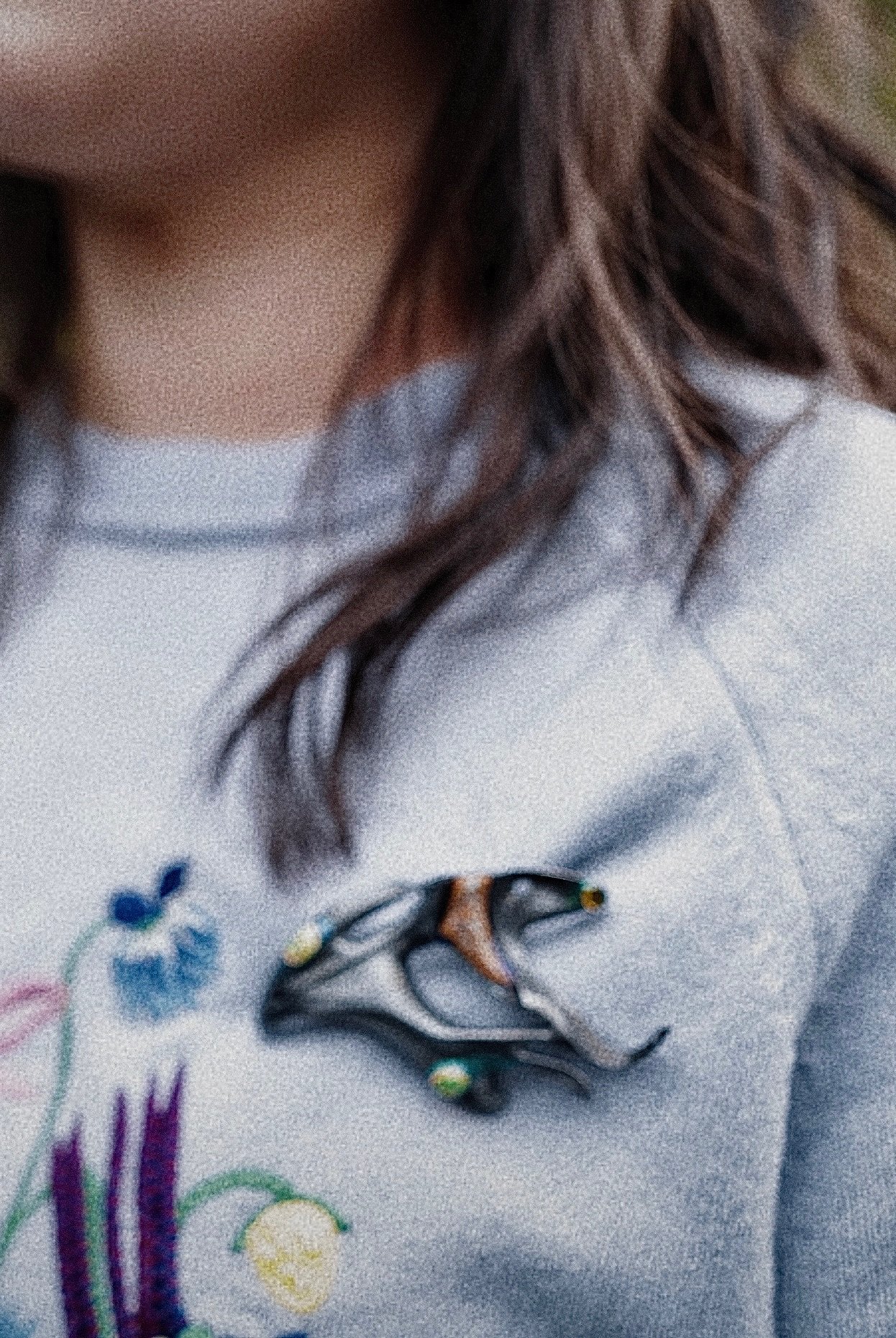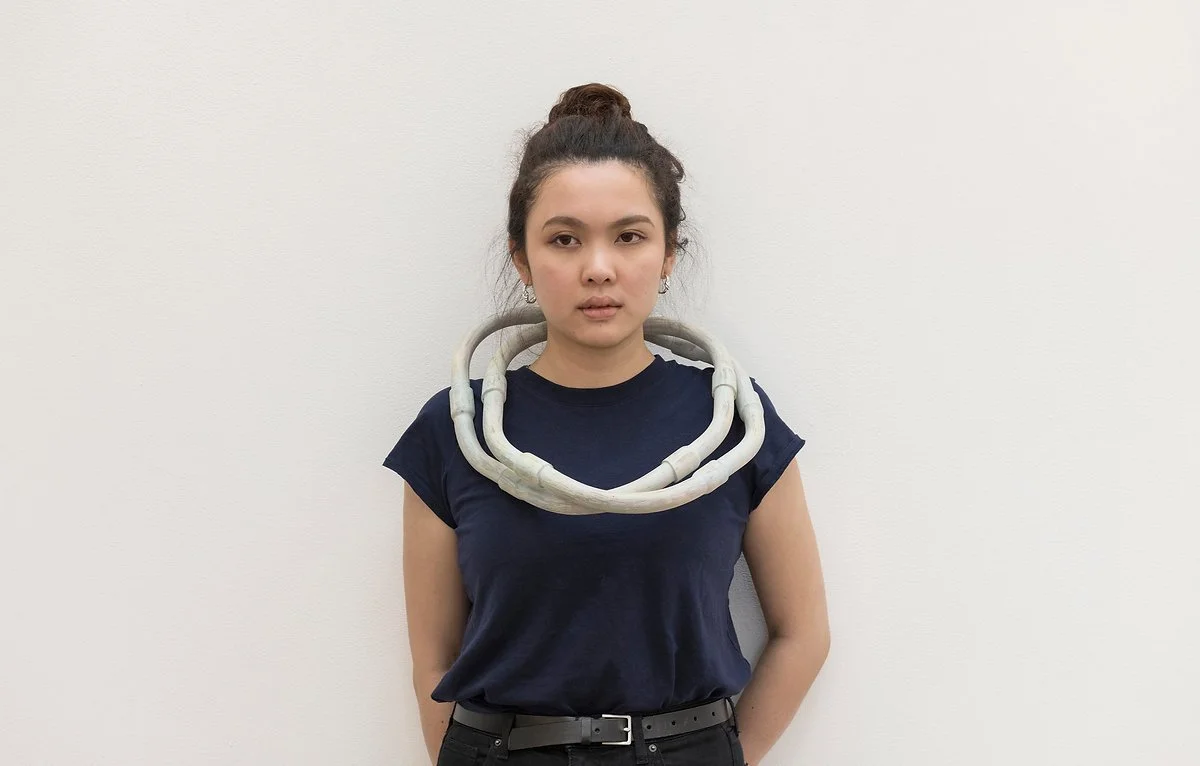10 Questions with Dijun Sha
Dijun Sha (Shine Sha) is a London-based multimedia artist, jewellery designer, and curator whose work bridges the gap between traditional craftsmanship, digital innovation, and curatorial storytelling. With a background in CAD modelling, digital jewellery, and Augmented Reality (AR) design, Dijun’s practice is deeply rooted in narrative-driven creation, transforming jewellery from a wearable object into an interactive, conceptual medium.
Trained at the London College of Fashion and Kingston University, Dijun specializes in exploring jewellery beyond its conventional role, integrating motion, technology, and cultural heritage into her work. She approaches design with a curatorial mindset, considering not only the physical form of jewellery but also its context, history, and the way audiences engage with it. As a curator, she weaves together exhibitions and artistic experiences that redefine how jewellery is perceived in contemporary society.
Her ongoing collaboration with Chen Qin, a master of sandalwood fan-making and inheritor of China’s intangible cultural heritage, reflects her commitment to fusing heritage craftsmanship with modern digital aesthetics. This partnership brings traditional techniques into dialogue with new media, creating a compelling contrast between physical craftsmanship and digital interactivity.
Dijun has been featured in multiple exhibitions, showcasing her ability to merge jewellery, storytelling, and digital experiences. As she prepares for upcoming showcases, she is also set to launch her jewellery brand, SSHINE ALIGN, in 2025—a platform that will further explore jewellery as a tool for storytelling, self-reflection, and innovation.
Dijun Sha - Portrait
ARTIST STATEMENT
At the heart of Dijun’s practice is the fusion of cultural heritage with modern technology. By integrating AR filters, moving images, and interactive experiences with traditional jewellery-making techniques, Dijun aims to redefine how jewellery functions in the contemporary world—moving beyond personal adornment to become a tool for storytelling, reflection, and engagement.
Since 2022, Dijun’s work has been shaped by a philosophical exploration of personal choices and life trajectories. Her series Trajectories draws inspiration from nature and decision-making, visualizing the paths we take, the marks we leave, and the unpredictable nature of our journeys. By translating these ideas into interactive jewellery and digital experiences, she encourages audiences to reflect on their own narratives and reconsider the meaning of jewellery in their lives.
As both a designer and curator, her approach extends beyond individual pieces. She creates immersive experiences such as AR Jewellery filters and moving images that invite audiences to engage, interpret, and connect with the work. Whether through an interactive digital space or a physical exhibition, Dijun designs with the intention of sparking dialogue, challenging perceptions, and expanding the role of jewellery in the digital era.
By blending technology, heritage, and conceptual storytelling, Dijun strives to push the boundaries of what jewellery can be, creating a new language of adornment that speaks to both the past and the future.
Journey is a necklace, Jewellery, 60x3 cm, 2024 © Dijun Sha
INTERVIEW
Let’s start with your background. Who are you, and how did you develop into the artist you are today?
I am Dijun Sha, also known as Shine Sha, an artist whose work exists in the space between the visible and the invisible, the physical and the digital. My practice spans jewellery, moving images, AR, and installation—each medium serving as a fragment of my exploration into identity, perception, and the subconscious. I am fascinated by the fluid nature of selfhood, how our choices shape us, and the unseen forces that guide our trajectories.
Jewellery, to me, is a sculptural form of storytelling, a tangible trace of movement and transformation. My Trajectory series embodies this philosophy, capturing life’s transient moments in wearable forms. Influenced by contemporary art, philosophy, and cultural heritage, my work blurs the boundaries between disciplines, existing both in the real world and indigital realms. Ultimately, my practice is about questioning what we see, what we don’t, and what exists beyond perception.
Your work seamlessly integrates traditional craftsmanship with digital innovation. What initially drew you to explore the intersection of jewellery design and technology?
My journey into jewellery began with traditional training at the London College of Fashion, where I honed the meticulous craft of hand-making. However, I soon realised that traditional methods alone could not fully materialise my concepts. In 2020, I immersed myself in digital tools—self-teaching CAD modelling, animation, and digital rendering.
The pandemic, though restrictive, became a time of transformation. Technology gave me the freedom to experiment limitlessly, refining ideas before they took physical form. It allowed me to construct intricate structures beyond the constraints of manual techniques, bridging craftsmanship with contemporary innovation.
Jewellery, in my vision, is no longer confined to the body; it exists in multiple dimensions, expanding into AR and virtual spaces. This synthesis of technology and craftsmanship has not only broadened my artistic language but also enabled me to collaborate across disciplines, creating jewellery that exists as both physical object and conceptual and interactive experience.
Show Yourself Tiara, Jewellery, 18x21 cm, 2021 © Dijun Sha
You’ve trained in CAD modelling, digital jewellery, and AR design. How does your technical background influence your creative approach, and do you see technology as an extension of craftsmanship?
For me, the act of creation is a conversation between the hand and the digital realm. I begin with fluid, intuitive sketches—capturing ideas in their rawest form—before translating them into digital models where structure and materiality are refined.
Rather than viewing technology as a replacement for craftsmanship, I see it as an evolution of making. 3D printing, CNC machining, and digital sculpting allow me to realise forms that defy traditional techniques, while hand-finishing ensures that each piece retains a sense of imperfection, tactility, and soul.
Jewellery is an ancient art form, deeply rooted in materiality and ritual. By integrating digital processes, I challenge the notion of permanence, creating works that exist both physically and virtually. This duality allows for continuous transformation—pieces that shift between being worn, displayed, or experienced in digital space. My goal is to push the boundaries of jewellery, transforming it into a multidimensional art form.
Jewellery is often viewed as a purely decorative, yet your work transforms it into an interactive and conceptual medium. How do you challenge conventional perceptions of jewellery?
Jewellery has always been an intimate medium, worn close to the body, carrying personal significance. But beyond ornamentation, it is also a vessel for ideas, a conceptual language that interacts with the wearer and their environment.
My work challenges the traditional boundaries of jewellery, treating it as both sculpture and storytelling artefact. Through digital techniques, I expand its function beyond the physical—allowing it to exist in AR, moving images, and virtual spaces. This interactivity invites the audience to engage with my pieces beyond touch, experiencing them as evolving forms rather than static objects.
Jewellery, in my vision, is an extension of the self, a bridge between the past and the future, between craftsmanship and digital art. It is a space where intention and unpredictability coexist. By integrating new technologies, I aim to transform it into a dynamic, multidimensional art form—one that moves, changes, and breathes.
Decision is a bracelet, Jewellery, 17x4 cm, 2024 © Dijun Sha
Infinity is an earring, Jewellery, 8.0 x 3.0 cm, 2024 © Dijun Sha
Your collaboration with Chen Qin bridges heritage craftsmanship with digital aesthetics. What have you learned from working with a master of sandalwood fan-making, and how do you see tradition and innovation coexisting in your work?
Growing up between Suzhou, China and London, UK, I was always aware of the fragility of traditional heritage craftsmanship. Many heritage techniques are fading, their significance lost in an age of rapid industrialisation. I feel a deep responsibility to preserve and reinterpret these art forms through a contemporary lens.
My collaboration with Chen Qin—a master of sandalwood fan-making—was born from this desire. Sandalwood fan,historically revered for its fragrance and delicate carvings, becomes the medium through which past and future converge.I incorporate 3D CAD Modelled structures into wax injection as purple wax models, then cast into 925 Sterling Silver, finishing all making steps by hand, lastly set the natural Opal and hand-carved 3D Sandalwood pieces to finish, allowing two seemingly opposing techniques to coexist in harmony.
This collaboration is more than a technical fusion; it is a dialogue between time periods, a way of reawakening forgotten artistry. By merging digital tools with traditional craftsmanship, I hope to create a new language for contemporary jewellery—one that respects heritage while embracing the boundless possibilities of innovation.
Your series, Trajectories, explores themes of decision-making and life paths. Can you share how this concept translates into your jewellery and interactive experiences?
Life is a series of choices, each decision leaving an invisible trace—a trajectory. What if every path we didn’t take continues to unfold in another realm? This idea became the foundation of my Trajectory series.
Jewellery, to me, is a vessel for these unseen narratives. The pieces in this series explore movement, transformation, and the interplay between intention and chance. Some designs resemble fluid, organic forms, capturing the essence of impermanence; others are structured, echoing the complexity of our personal journeys.
By integrating digital elements, Trajectory series also exists beyond the physical—it can be worn, experienced in AR, or transformed into digital sculptures. In doing so, the series challenges the idea of jewellery as a static object, instead treating it as an evolving, interactive form. It invites the wearer to contemplate the paths they have chosen—and the infinite possibilities that remain unseen.
Life is a brooch, Jewellery, 7.8x4.1 cm, 2024 © Dijun Sha
You use AR filters and moving images to engage audiences beyond physical objects. What excites you most about using digital tools, and how do you see this evolving in the future?
Physical works exist within the limits of space and time, but digital art transcends these boundaries. By incorporating AR, moving images, and virtual renderings into my practice, I am able to create works that shift between dimensions, existing in both material and immaterial spaces.
Augmented reality allows my jewellery to extend beyond the body, interacting with digital landscapes. Moving images bring these pieces to life, capturing their transformation over time. These tools do not replace traditional craftsmanship; instead, they amplify its meaning, allowing jewellery to exist as a fluid, ever-changing entity.
In a world increasingly shaped by technology, I see digital tools as essential to artistic evolution. They expand the ways in which we create, experience, and share art. By merging digital and physical forms, my work challenges the notion of permanence, creating pieces that breathe, transform, and transcend the limitations of the tangible.
In 2025, you’re launching your jewellery brand, SSHINE ALIGN. What vision do you have for this platform, and how does it reflect your philosophy on jewellery as a form of storytelling?
SSHINE ALIGN is not just a jewellery brand—it is a philosophy, a living narrative, a space where heritage and futurism intertwine. Jewellery has always been more than adornment; it carries memory, identity, and cultural echoes. With SSHINE ALIGN, I seek to expand this dialogue, transforming jewellery into an experience rather than an object.
This platform bridges ancient craftsmanship with digital innovation, crafting pieces that shift between dimensions—tactile and virtual, intimate and expansive. Through AR, motion, and evolving materials, each design becomes a portal, reflecting themes of movement, identity, and transformation.
At its core, SSHINE ALIGN is an invitation—an open space for collaboration, conversation, and co-creation. I hope it becomes a meeting point for those who, like me, believe that jewellery can be more than wearable art—it can be an evolving story, one that aligns us with the past while shaping the future.
Karma is a ring, Jewellery, 3.75x3.7 cm, 2024 © Dijun Sha
You’ve exhibited your work internationally. How do different cultural contexts shape the reception of your designs, and do you tailor your work differently based on the audience?
As an artist drawn to experimentation, I often create multiple versions of my works, each resonating with different audiences in distinct ways. While the core concept remains unchanged, I consider cultural perceptions, history, and materiality when shaping how my pieces are presented.
Material choices play a crucial role—sandalwood, for example, carries deep cultural significance, embodying longevity and natural harmony. Sustainability is also integral to my process. By embracing digital exhibitions and AR, I reduce the carbon footprint of transportation and explore alternative ways to experience jewellery beyond physical constraints.
The contemporary art world is vast, yet contemporary jewellery remains a niche realm. Rather than tailoring my designs to fit specific markets, I focus on refining how they are communicated—allowing my work to remain fluid, adapting in meaning while staying true to its essence. Art should invite dialogue, not be confined by borders.
Lastly, looking ahead, what upcoming projects or collaborations are you most excited about, and how do you see your practice evolving in the coming years?
With SSHINE ALIGN launching this year, I look forward to witnessing its dialogue with the world—how it resonates with artists, designers, and those who seek meaning beyond ornamentation. The market’s response intrigues me, but even more so, the potential for collaboration.
Heritage craftsmanship is a tapestry woven with countless stories, each region holding techniques on the verge of fading. If the art world is an intricate web, I see design as the needle—stitching together tradition and innovation, preserving the old while reshaping the new. I dream of working with master artisans across disciplines, expanding the boundaries of function and form.
Installation and sculpture have always been my passions, and I envision SSHINE ALIGN as more than a brand—it will be a space of convergence, a living forum where artists, thinkers, and makers engage. Together, we can redefine contemporary art, making it more immersive, interactive, and accessible.
Artist’s Talk
Al-Tiba9 Interviews is a promotional platform for artists to articulate their vision and engage them with our diverse readership through a published art dialogue. The artists are interviewed by Mohamed Benhadj, the founder & curator of Al-Tiba9, to highlight their artistic careers and introduce them to the international contemporary art scene across our vast network of museums, galleries, art professionals, art dealers, collectors, and art lovers across the globe.





















